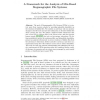Free Online Productivity Tools
i2Speak
i2Symbol
i2OCR
iTex2Img
iWeb2Print
iWeb2Shot
i2Type
iPdf2Split
iPdf2Merge
i2Bopomofo
i2Arabic
i2Style
i2Image
i2PDF
iLatex2Rtf
Sci2ools
128
click to vote
ESORICS
2008
Springer
2008
Springer
A Framework for the Analysis of Mix-Based Steganographic File Systems
Abstract. The goal of Steganographic File Systems (SFSs) is to protect users from coercion attacks by providing plausible deniability on the existence of hidden files. We consider an adversary who can monitor changes in the file store and use this information to look for hidden files when coercing the user. We outline a high-level SFS architecture that uses a local mix to relocate files in the remote store, and thus prevent known attacks [TDDP07] that rely on low-entropy relocations. We define probabilistic metrics for unobservability and (plausible) deniability, present an analytical framework to extract evidence of hidden files from the adversary's observation (before and after coercion,) and show in a experimental setup how this evidence can be used to reduce deniability. This work is a first step towards understanding and addressing the security requirements of SFSs operating under the considered threat model, of relevance in scenarios such as remote stores managed by semi-tru...
Related Content
| Added | 19 Oct 2010 |
| Updated | 19 Oct 2010 |
| Type | Conference |
| Year | 2008 |
| Where | ESORICS |
| Authors | Claudia Díaz, Carmela Troncoso, Bart Preneel |
Comments (0)

